Viewing and Modifying Work Orders in SC Mobile
Jing Tong (Unlicensed)
Caroline Antoun
Natalia Larina (Unlicensed)
SC Mobile does not follow permissions based on Location Note Headers.
From the work orders list, you can:
- View work order details
- Dynamically filter work orders by status, category, priority, trade, provider, and weather type
- Modify work order details, including reassign work orders (for permissioned users)
You may also create a new work order and view/add notes and attachments.
Users with access to only one location do not have to select a location.
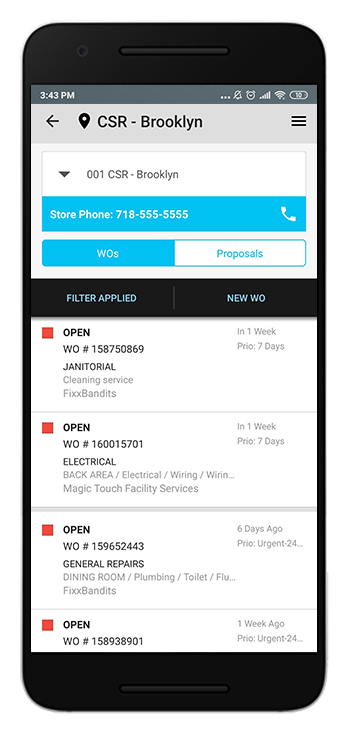
- On the SC Mobile home screen, tap Locations.
- Locate and tap the desired location. Work orders for that location appear.
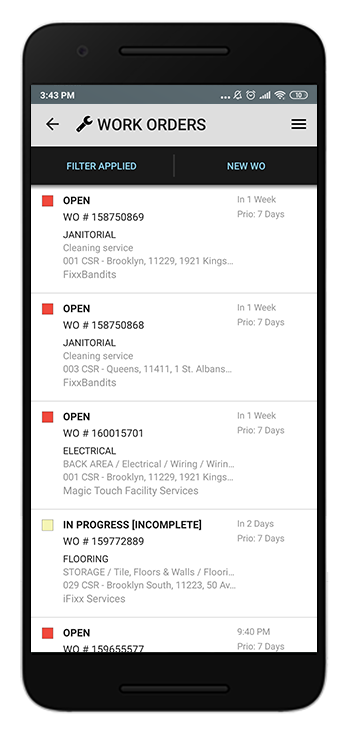
- On the SC Mobile home screen, tap WOs. The Work Orders screen appears, listing work orders for all locations to which you have access.
Viewing Work Order Details
The Work Orders list displays work orders for the past 90 days and 90 days in the future. This list provides a brief overview of each listed work order. To view more details, tap a work order.
Work Order Overview
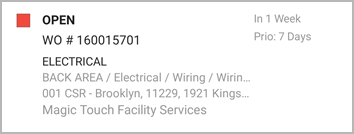
- Work Order Status: A colored box indicating the status the work order is in, in line with the statuses in Service Automation. In this example, the work order is in the Open status.

- Work Order Highlights: You can see the WO trade, issue description, location info, and the assigned provider. The work order shown in the image above has the following parameters:
- The work order trade is “Electrical”.
- The issue description is “BACK AREA / Electrical / Wiring...”.
- The Location ID is “001” located in “Brooklyn 11229”.
- The service provider is “Magic Touch Facility Services”.
Budget Insights. In this section, you will see how the In-Progress or Completed work order aligns with the budget assigned to it.
Clicking on the Budget section brings you to the Budget Details page. If the work order is not assigned to the budget, you will see a note saying the work order is not assigned.
 Expand the section to learn more about Budget Insights on the work order.
Expand the section to learn more about Budget Insights on the work order.You will see the general information about the budget you currently viewing:
a. The Budget Level section. You can navigate between the calendars and periods to view how the work order influences your budget at different budget levels.
b. Tracking Number. The tracking number of the work order.
c. Tracking Number Budget Value. The value of the work order budget amount the budget is assigned to.
d. The Fiscal Year Name and Fiscal Period at the selected budget level.
e. The Fiscal End date shows the end date when the selected budget level becomes inactive.
f. The Budget Risk Status shows how the work order relates to the selected budget period or calendar. It may have one of the following 3 statuses:
- On Track. If a work order NTE amount fits in with your budget and forecasted expenses, you will see this status.
- At Risk. Shows that a work order amount may potentially lead you to going beyond the budget, and you should pay attention to it.
- Overspend. This status means the work order amount is already beyond your budget for the selected period.
g. The Remaining Budget Amount in the currency you specified for your budget. The amount changes as you change the fiscal period or fiscal calendar the proposal relates to.
h. NTE. The Not-to-Exceed amount of the work order.
i. The Amount Types for the selected budget period display the spend types (incurred, forecasted, total budget for a certain period).
The incurred budget is calculated based on the Completed work orders for a given fiscal period. The fiscal period is determined by the work order completion date.
The forecasted budget is calculated:
- Based on the average invoice amount for similar work orders in the same Trade and Category as the analyzed work order assigned to the budget over the past 12 months.
- If work orders assigned to the budget have Approved proposals, then the Not-to-Exceed amount is used in the calculation instead.
The fiscal period is based on the scheduled date of the In-Progress work orders and the completion date of the Completed/Not Invoiced work orders.
- Scheduled Date: The number of hours and/or days after the Call Date when the service provider should check in to perform work on the requested service. In this example, the service provider is scheduled to arrive “In 1 Week”. When a provider is scheduled to arrive today, you will see a specific time. Otherwise, you will see either “In x days” or “x Days Ago” or “x Month(s) Ago”.
- Priority: Period during which a service provider should check in to perform the requested service. In this example, the priority is “7 Days”.
Filtering Work Orders
You can filter work orders by Status, Category, Priority, Trade, Provider, and Weather Type. This is beneficial, for example, when you want to view only repair work orders, in-progress work orders, or emergency work orders. You can choose up to 4 filters. The Default filter displays work orders in all statuses, categories, priorities, trades, providers, and weather types with scheduled dates over the past 3 months. You can make adjustments to this default filter in case you always want to display certain work orders, such as those only in the repair category, or those only in a subset of statuses, or those going back 6–12 months. You can also keep this filter as is so you’ll have a quick way to reset other filters. |
|
You can also create custom filters to hone in on the exact work order set you need. In this example, the filter is configured to display work orders with the following parameters:
You can name the filter in a way that clearly describes the filter. In this example, the filter is titled “Emerg Open/InProg Repairs.” |
|
Once the filters are applied, they remain turned on — even when you quit the app or log out. You must either apply the default filter (in case you left it unchanged) or reset the default filter to see all work orders for the location. We recommend resetting the Default filter so you do not lose changes to your custom filters. |
|
- On the Work Orders list screen:
- (When no filters are applied) Tap Filter WOs. The Filter Work Orders screen appears.
- (When a filter is applied) Tap Filter Applied. The Filter Work Orders screen appears, highlighting in white the filter that is currently applied.

- In lower-left corner of the desired filter, tap Apply. The work order list updates based on the applied filter’s criteria.
- On the Work Orders list screen, tap Filter WOs / Filter Applied. The Filter WOs screen appears.
- Tap the + plus icon at the top of the screen. A new filter modal appears.
- Tap the pencil icon to give the filter a name.
- Use the slider to view work orders by scheduled date, from 1 month to 12 months.
- Tap each criterion to select Statuses, Categories, Priorities, Trades, Providers, and Weather Types, and then tap Apply (#) at the bottom of each filter.
- After selecting choices for each criterion, tap Apply on the filter modal. The work order list updates based on the filter selected.
We recommend leaving the default filter unconfigured so you can easily turn filters off. In case you configured the default filter, the criteria must be reset to turn filters off.
- On the Work Orders list screen, tap Filter Applied. The Filter WOs screen appears.
- On the Default filter, do one of the following:
- (When Default is not configured) Tap Apply. The Filter Applied area changes to Filter WOs.
- (When Default is configured) Tap Reset, and then tap Apply. The Filter Applied area changes to Filter WOs.
Work Order Details

Tap a work order to view its details.
Name | Definition |
Status** | The current status of the work order. |
Priority** | Period during which a service provider should check in to perform the requested service. |
Related Proposals* | The list of Proposals linked to the work order, along with the proposal status. (See Viewing and Taking Action on Proposals in SC Mobile for more information.) |
Schedule Date** | The number of hours and/or days after the Call Date when the service provider should check in to perform work on the requested service. |
Call Date | The date and time the work order was generated. |
Caller | The person who submitted the work order. |
Trade** | The line of work under which the work order falls. |
| Weather Type | Weather type related to the work order. |
Provider / Provider’s Phone* ** | The company assigned the work order. Tap the provider’s name to dial the phone number. |
NTE* ** | An acronym for not to exceed: the maximum amount the service provider may charge for the service listed on the work order. Should you need to change the decimal point (.) to decimal comma (,) on monetary amounts, contact your ServiceChannel representative. |
Recall | Whether the current work order is a recall from an earlier job. |
Tracking Number | Unique identifier of the work order. The number is generated automatically and cannot be changed. |
| Work Order Number | Non-unique identifier of the work order. |
Purchase Order Number** | Purchase order number that you can edit if permissioned. |
Description** | Problem details entered while placing the service request. |
Category** | The overall classification of a WO, such as Maintenance, Repair, or CAPEX. |
Last Note | Notes added to a work order. Notes can be entered manually by users or service providers or created automatically by the system. |
| Pinned Note | Note that is most important to you that highlights the current state of the work order. Only one note can be pinned at a time. |
* = Your system configuration determines if you can see Related Proposals, Provider’s Phone, and/or NTE.
** = Users with edit permissions can see a pencil icon next to editable fields. See Modifying a Work Order below for more information.
Modifying Work Order Details
Permissioned users may edit various work order details in SC Mobile. A pencil icon indicates the field(s) you can edit. The following fields may be modified:
- Status, Priority, Trade, and Category
- Scheduled Date and NTE
- Description
- Purchase Order Number that can be a maximum of 50 alphanumeric characters
- Assigned provider (See Reassigning a Work Order below.)
Your permissions set by your administrator determine which of these fields you can edit. Users who have edit rights in Dashboard can only edit work order statuses.
- On the desired field, tap the pencil icon to update the related information.
- Modify the desired details, and tap Save. The work order is updated.
- (For Provider and Trade fields) Tap Reassign. (See Reassigning a Work Order below.)
Reassigning a Work Order
Permissioned users may reassign a work order to another service provider when the original provider is not able to service your location. This may be for various reasons — examples might be because the provider is not able to make the scheduled date or the work order was created under a specific trade and the provider does not service that trade.
On the screen listing work order details, tap either Trade or Provider. The Reassign WO screen appears.
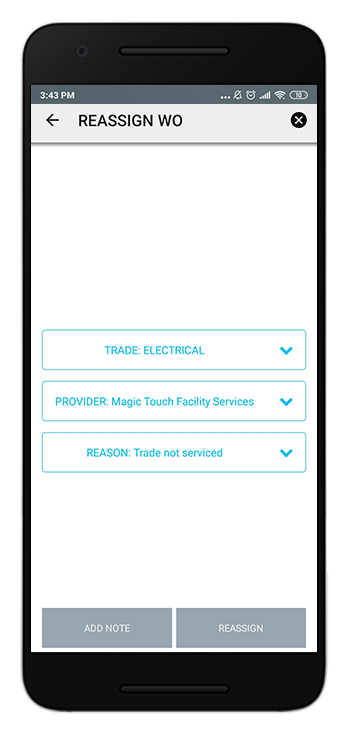
To modify the Trade and/or Provider, tap the corresponding menu, and select the desired option.
Providers who are grayed out on the providers list were flagged as “Do Not Dispatch” by your company in Compliance Manager and thus cannot be assigned new work orders. Learn more about “Do Not Dispatch" providers.
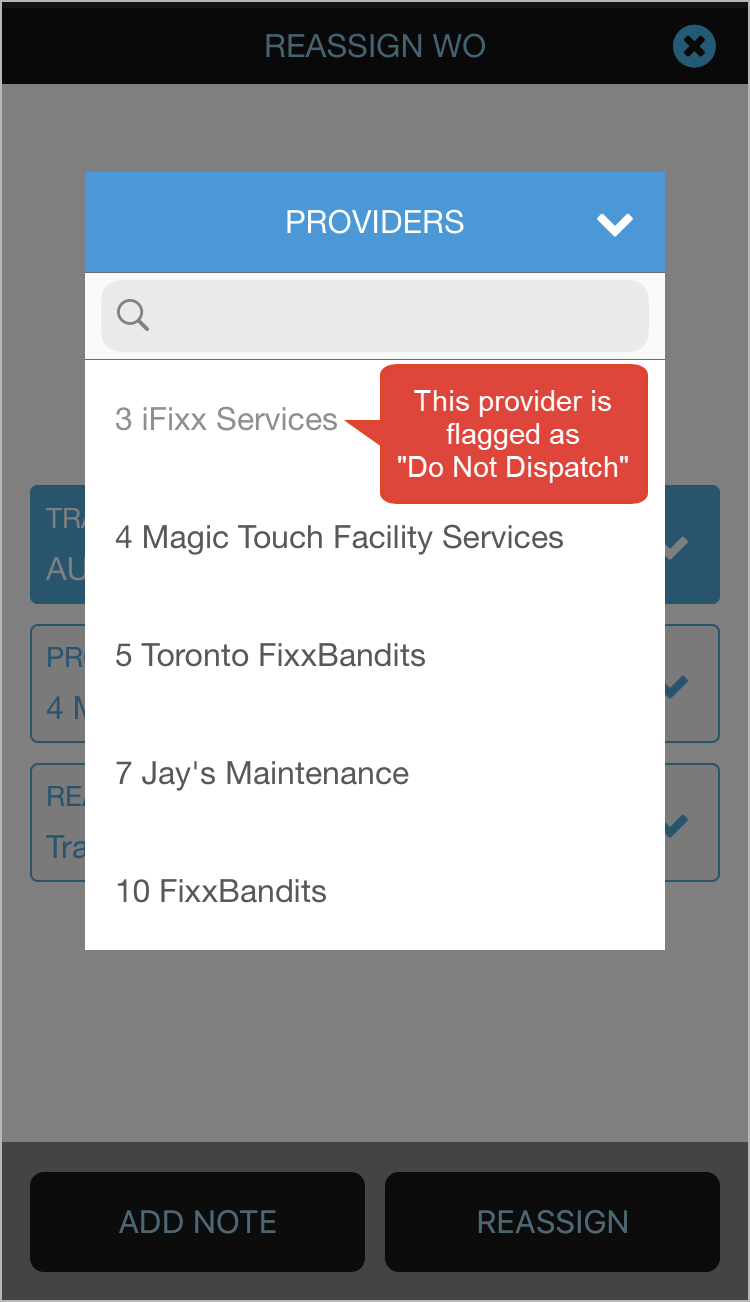
- Tap Reason, and select the reason why you are reassigning the WO.
- Tap Reassign to confirm the reassignment.
Once you reassign a work order, its scheduled date is automatically updated based on the work order priority. If necessary, you can adjust the scheduled date later on from the work order details screen.
Creating a Work Order
From the Work Orders list page tap New WO, and then follow the steps to create a new work order.
-
Page:
-
Page:
-
Page:
-
Page:
-
Page:
-
Page:
-
Page:
-
Page:



